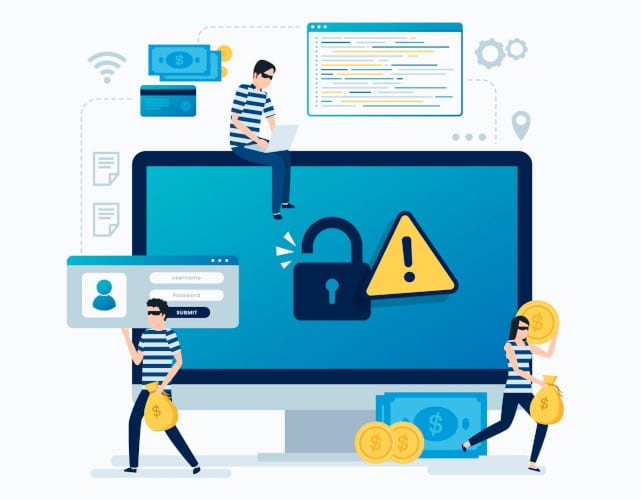In 2023, 49% of companies reported experiencing a cyberattack. After a brief period of decline in 2022, hackers have made a strong comeback, with ransomware becoming their weapon of choice. By immobilizing an organization's IT systems, hackers gain the perfect leverage to extort a ransom, highlighting the critical need for robust defensive measures.
What is a ransomware?
Definition
Ransomware is a specific kind of malicious software designed to block access to a computer system until a ransom is paid. Typically, victims are greeted with a message on their screen denying access to their data and files, which are effectively held hostage.
But how does this process work? It begins with the simple act of opening an attachment, clicking on a malicious link in an email, or visiting an infected URL. These vectors allow the hacker to breach the information system, where they can then encrypt the data, rendering it inaccessible. Access is only restored with a decryption key, which, unfortunately, is in the hacker’s possession. They don’t offer this key freely – it comes with a demand for a ransom, a demand that is made clear when a message appears on the screen outlining the ransom details.
Good to know: Hackers often request ransom payments in Bitcoin or other cryptocurrencies because these are more difficult to trace, facilitating the cybercriminal’s escape.

A bit of history
The development of ransomware has progressed hand-in-hand with the advancement of computer technology. Notably, the first ransomware emerged in 1989 with the “AIDS Trojan.” Victims had to send payments to Panama, a location chosen for its financial secrecy before the advent of digital currencies.
As these malevolent practices widened, the term “cryptoviral extortion” was coined as early as 1996.
Through the years, hackers have continually honed their creative abilities, enabling them to target organizations across all sectors and sizes: from private individuals to SMEs, hospitals, governmental bodies, and large tech corporations. No one is immune to ransomware.
What are the different types of ransomware?
To successfully extort funds, hackers employ a wide range of ransomware tactics. The primary forms include:
- Encryptors: These encrypt the data on a computer, effectively locking access. A decryption key is required to regain entry.
- Screen lockers: These prevent access to the computer by displaying a “locked” screen, making all major functionalities unusable.
These categories then branch out into various ransomware variants, with differing levels of notoriety, such as:
- WannaCry: a ransomware that infected over 250,000 systems worldwide.
- CryptoLocker: among the first to demand ransom in cryptocurrency, this malware targeted victims through FedEx and UPS tracking notification emails. Opening the attachment granted hackers unrestricted access to encrypt the hard drive and any connected network drives. It amassed over 27 million dollars in total.
- NotPetya: this variant targets and encrypts the master boot record of Windows-based systems, causing irreparable system damage.

How to protect against ransomware?
The success of ransomware among cybercriminals is partly due to their exploitation of security loopholes. It is essential for organizations to mitigate vulnerabilities. Key preventive measures include:
- Educating users: Given that human error is often the root cause of security breaches, educating all team members on risks and best practices is essential. For instance, enforcing complex passwords, frequent password changes, and ensuring computers are turned off when not in use are good practices.
- System and application updates: Outdated software is more vulnerable to attacks. Keeping software up to date is crucial for reducing potential entry points.
- Data backups: Keeping backups not just locally but also in remote locations ensures data access if the primary system is compromised.
- Email protection strategies: With 81% of attacks initiated via email, strengthening email security is imperative. Email security best practices can help mitigate this risk.
How to respond to a ransomware?
The repercussions of ransomware for organizations can be severe, leading to data loss, operational disruptions, reputational damage, and financial setbacks. The instinct may be strong to pay the ransom to recover access to systems.
This is a grave mistake.
On one hand, acquiescing to the demands of hackers only fuels their criminal activities, as profitability encourages them to continue their exploits. Furthermore, funding these cybercriminals gives them more resources to grow their operations, discover new breach methods, and target more substantial infrastructure. In essence, paying the ransom indirectly supports the malicious hacking ecosystem.
On the other hand, paying the ransom offers no guarantee of regaining access to computer files. Some hackers have motives beyond monetary gain, seeking instead to inflict operational damage or tarnish an organization’s reputation.
How to become a cybersecurity expert

In the face of ransomware, now a plague to all organizations regardless of size or sector, the need for robust defenses has never been greater. Becoming a cybersecurity expert might be your calling. And for that, education is key. At DataScientest, we provide comprehensive IT security training to help you anticipate risks and take effective action in the event of a ransomware attack. Cybersecurity tips from experts can also guide your path to becoming a cybersecurity expert.










